Tank building in the USSR, 30-ies
However, at the very beginning of this path - by the way, it was already with the fact that it was borrowed from the West during the years of Peter the Great’s reforms - the Russians were very shy about somehow improving their cars.
So, for the prototype tank The Vickers 6-ton, known as TMM-1, from the very beginning decided to put three machine guns, and not two, like on an English tank, and increase the crew per person. But even the improved version of TMM-2 did not satisfy the military, and it was the Vickers with the most minimal alterations that went into the series.
Soviet experienced light tank TMM-1
Like the English prototype, the T-26 had two independently rotating turrets with machine guns. According to the British, such a deployment of weapons was to ensure the maximum rate of fire on both sides, which was considered particularly important for an infantry tank.
And with the opinion of the British in the USSR were considered at the highest level. So, for example, having familiarized with the Vickers-6 tons tank purchased in England, M. Tukhachevsky wrote the following (style and spelling preserved): “With regards to the recently inspected Vickers English tank, I found it in the best way possible to accompany an enemy trench when attacking ... The location of the tank towers side by side very advantageously allows the tank to develop a strong side fire at the intersection of the trench and trenches, which does not cover the parapet in any way ... It is not difficult to understand that the two-tower and three-tower schemes are therefore English Anami, which are very promising and most beneficial for overcoming enemy defenses among their own infantry. ”
But it soon became clear that, contrary to M. Tukhachevsky’s opinion, a tank most often had to fire at one target, but in this case it was impossible to concentrate fire on one side.
This became especially noticeable when an 1932-mm gun was placed in the right tower in 37. The tank's firepower seemed to have increased, but now the towers were interfering with each other in the distribution of the power of fire. Although there were only about 1600 of such tanks, they decided to abandon the double-stormed version later, and the X-NUMX T-26 of the sample already received one turret armed with an 1933-year tank gun of the DT machine gun paired with it. The commander’s tanks were equipped with an antenna in the form of a handrail around the tower, but the experience of the battles showed that the enemy, noticing such a tank, primarily shoots at him, which is why the handrail antenna was replaced with a whip antenna, which was not so noticeable from afar.
In 1936, the tank received a machine gun in the aft niche of the turret, and in 1937, another one was anti-aircraft, mounted above the commander's hatch. At the same time, the T-26 tanks were equipped with a conical turret, and with 1939, they placed slanted armor plates on the turret box. Engine power gradually grew, but the weight of the tank also increased, due to which the reliability of the undercarriage steadily decreased. Finally, to enhance protection, about a hundred tanks during the Soviet-Finnish war were urgently booked by hanging screens on them. The thickness of the lower front part of the body and the front wall was brought to 60-mm. Sometimes these machines are called T-26E. However, they were clearly over-heavy and, due to their low mobility, were a good target.
The production of T-26 was stopped in the first half of 1941, but in July-August 1941 in Leningrad completed about a hundred cars from an unused body stock. In total, the Red Army received more than 11 000 T-26 23 series or modifications, including flamethrower (then called "chemical") and engineer-laying tanks.
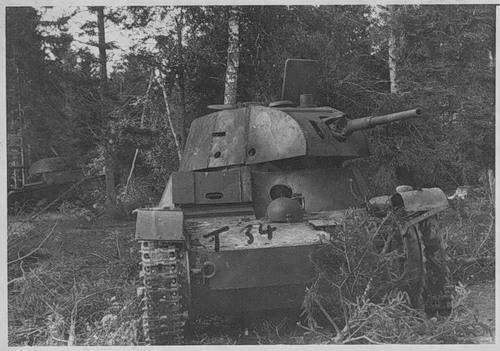
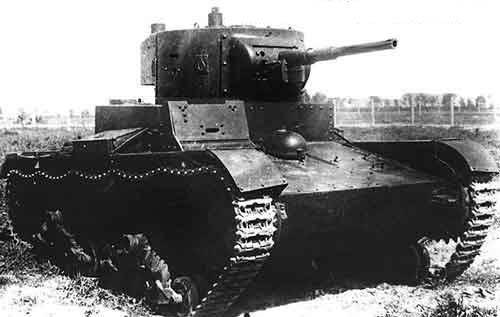
Soviet tank T-26, model 1932
In 30-s. T-26 served as the basis for the development of the first domestic SAU, for example, SU-1 and SU-5-1 with 76, 2-mm gun, SU-5-2 with 122-mm howitzer and SU-5-3 with 152-mm mortar. The AT-1 "artillery tank" was designed, which had an 76,2-mm gun and even an 76-mm self-propelled anti-aircraft gun SU-6. Interestingly, in the chassis of this machine was used another middle roller, which had a sewage suspension. On both sides of the hull, the sides were hingedly reinforced by the sides to protect the calculation while moving, which, when they were reclined horizontally, served as a platform for the calculation action. SU-6 could leave the position without moving to the traveling position, it was necessary only to raise the front armor of her.
76,2-mm experimental anti-aircraft self-propelled unit SU-6 (based on the light tank T-26) USSR
On trials it was noted that weapon swinging when firing, that the tip gets off, and the engine is overheating. The fact that this anti-aircraft SU was very easy to turn into an anti-tank one was not noticed by the designers, although it was enough for this to lower the tool pick-up line in a horizontal position and install a muzzle brake on the barrel, softening the recoil force. The most interesting thing is that during the war years, having acquired the captured T-26 tanks and French guns of the 1897 model in the hands, the Germans did just that, although it is clear that it was not from a good life.
By the way, the short-barreled 76,2-mm cannon on the tank for the first time in our country was also installed on the T-26A (artillery) tank. T-26 sailed with inflatable floats and even walked along the bottom of the river (tank-26PH - “underwater passage”) with a pipe through which the engine “breathed”, in a word, played the role of a laboratory, where many solutions were tested that received later independent lives.
BT tanks had a chance to live in the Red Army no less bright life, although compared with T-26, their mastery of industry was much harder. The first BT-2 tank was not too different from its American prototype, but even in this form, its manufacture turned out to be very difficult. The low quality of the rubber led to its detachment from the steel band of the road wheels, while the wheels with the American rubber could withstand the mileage of 1000 km without any noticeable damage. The standard 37-mm guns of the B-3 guns, destined for this tank, were constantly lacking due to the semi-handicraft nature of their production, and military representatives constantly rejected the manufactured hulls and towers. So much so that 350 610 made in 1932-1933's. BT-2 had no guns and armed only with machine guns. In this installation of machine-gun installations was carried out by military units. In one of the military representative's reports on the fulfillment of the order for 1933, it was explicitly stated that, “despite the fulfillment of the program (instead of 1000 machines, 1005 was commissioned according to the plan), the quality of the machines cannot be considered good ... 5-8% machines per month were rejected for the first half of the year , for the second - 9-41%, which indicates a decline in attention to quality, especially in the assembly. "
True, then attempts were made to radically strengthen the armament of light tanks in general and BT in particular. So, 6 of June 1931 of I.A. Khalepsky approved a design task for a wheeled-tracked tank of the type of Christie, which with a weight within 14 t, booking 13-20-mm and speed not lower than 40 km / h - on tracks and 70 km / h - on the wheels had to be armed 37-mm and 76-mm cannons and two machine guns. And one gun and one machine gun were supposed to be installed in a rotating turret, and the rest - in the body. The crew of the car - no less than 3 people. According to these requirements, the RKKA experimental design and testing bureau, headed by N. I. Dyrenkov, developed the project and built a full-size model of the D-38 tank. 18 November The 1931 project was reviewed, but it was declared unsatisfactory.
The following year, using the experience of the D-38, the Dyrenkov Design Bureau manufactured and installed on the BT-2 tank an enlarged turret with an 76-mm regimental gun shortened recoil (previously installed on the SU-1) and a DT machine gun in separate installations. 25 March 1932 machine was tested at the artillery range of the Proletarian division, but because of the unsuccessful design of the gunfire and sticking the epaulettes of the tower when firing, this option did not go further than the prototype.
In 1933, the Krasny Putilovets Plant designed a cylindrical turret with an 76-mm cannon, the same for the T-26 and BT tanks, but it was also rejected due to a number of flaws. Everything ended with the unification of the towers for T-26 and BT tanks, which received a turret with an 45-mm gun of the 1932 model, which had an initial speed of an 760 armor-piercing projectile, m / s, and a DT machine gun paired with it. Interestingly, the caliber 45-mm appeared in the Red Army all of the same traditional for our military considerations of economy. The fact is that a huge amount of 47-mm armor-piercing shells of naval 47-mm guns of Hotchkiss has accumulated in Russian military warehouses. When grinding off the old leading corbels, the caliber of the projectile became 45 mm. So this thrifty royal admirals need to be thanked for the fact that they, without knowing it, have provided the Soviet tank building with substantial assistance in providing it with ammunition!
With the new turret, the tank became somewhat heavier, but its speed and booking did not change. BT-5 had a chance to fight on the Hal-hin-Gol River, as well as during the Spanish Civil War 1936-1939, in Poland and in the Soviet-Finnish campaign. 1933-1934 total 1884 BT-5 was released.
BT-5 5 th mechanized corps, 1935 g.
As for the operation of these machines in the prewar period, it revealed a lot of flaws in both BT-2 and BT-5. Due to the lack of an adequate number of spare parts for engines and spare tracks, up to 50% of the vehicles were ordered to be kept in the reserve pool by the troops, 25% was to be half exploited, and only 25% was fully used.
However, they liked their tank speeds for their excellent speed, and many of them even learned to jump from acceleration over obstacles to 15-20 meters, and some to all 40, on their cars!
In 1935, the launch of the new BT-7 tank, which had a new engine and a number of other improvements, was launched.
The first samples were produced with a cylindrical turret, which was soon replaced by a conical one; the tank ammunition depended on whether a radio station was installed there. The gun pointing mechanism in 1938 has been improved by introducing stabilization of the aiming line in the vertical plane. In 1936-1937 on the part of the tanks installed 76,2-mm CT gun with the initial velocity of the projectile 381 m / s (BT-7А), which was released 155 units.
Compared with the BT-5, the new car had an improved hull shape, thicker armor, a large fuel reserve and, therefore, a range.
The technical reliability of these machines has grown especially since the installation of the latest modification of the BT-1939M B-7 diesel engine in 2. Immediately increased speed and power reserve, since the diesel engine was primarily much more economical than a gasoline engine. Production of the BT-7М was stopped due to the transition to the release of the T-34 in the spring of 1940, and more than 8 of thousands of BT tanks of various modifications were produced in the USSR!
Soviet tank BT-7, 1935
Like T-26, at their base, experienced flamethrowing and even radio-controlled tanks — teletankas, according to the terminology of that time, SBT-bridge-laying tanks, which had a tower from the T-38 tank and a bridge span of 9 m. Were built. In 1935, on a BT-tank 5 tested a set of metal, and later - rubber floats to overcome water obstacles. As in the case of the T-26, there was a version of the BT-5 tank for underwater navigation - the BT-5PH, equipped with an air intake pipe for the engine and a set of rubber seals to seal the tank. The depth of its immersion in this case was 5 m.
The BT tanks, and mainly the BT-7, together with the T-26, were the main tanks in parts of the Red Army in the prewar period. They fought at Lake Hassan, at Khalkhin Gol, in Poland, Finland, and were also widely used at the very beginning of World War II.
In 1942-1943 individual BT-5 and even BT-2 tanks still participated in the battles. Together with them, BT-7 also fought, and both of them went to the Far East together with T-26 in their last battle, where in 1945 they again had a chance to fight with Japanese troops.
The first medium tank of the Red Army, in which the influence of the English tank school was just as obvious, was the T-28, created by 1931 and 1934.
The experienced tank had three turrets, the main of which was armed with an 45-mm gun, but on the production vehicles in the main turret they installed a short-barreled 76,2-mm cannon. In addition to it, the 2 machine gun was also in the turret — one front, another behind, and the front one was guided separately from the gun. Two more were in small machine-gun turrets on both sides of the driver's seat, which the designers believed, ensured the maximum rate of firing on both sides, as well as forward.
The average specific pressure on the ground 0,66-0,72 kg / cm2 - for such a machine was small, and a good choice of suspension elements provided a smooth ride and a fairly good cross. The suspension itself was covered by an armored bulwark, which at that time was a characteristic feature of medium and heavy tanks of the USSR.
In 1938, a more powerful 28-mm cannon with a barrel of 76,2 lengths of calibers was installed on the T-26, and in the last instances the cylindrical tower was replaced with a conical one.
During the “winter war” with Finland (1939-1940), insufficient armor protection was revealed, and some tanks were urgently booked using additional armored screens. The thickness of the frontal armor of the hull and turret reached 50-80-mm, onboard and stern - 40 mm, the tank mass increased to 31-32 t.
On the T-28, a mounted mine trawl was tested, and in 1938, an engineering IT-28 was manufactured with an 13-meter bridge with a load-carrying capacity of 50, t. minutes T-28 produced up to 38g. (more than 5 units), and they also participated in the battles of the initial period of the Great Patriotic War.
T-35 was intended for high-quality reinforcement of troops in the breakthrough of very strongly fortified positions of the enemy. His project was developed in 1932 year, the next year, after testing the prototype and finalization adopted for service and began mass production. He began to enter the army in 1934, before the 1939 of the Red Army received about 6С machines.
The T-35 was the strongest in terms of armament, the only serial five-turreted tank in the world. The turret of the tank was unified with the T-28 tank and had a polik rotating with it and an electric drive for rough guidance. In the two towers with 45-mm guns there were twin machine guns and in the other two only machine guns. Such an arrangement of weapons allowed the 76,2-mm and 45-mm cannons and 3 machine guns to be focused on and around any board. The small diameter 8 road wheels were interlocked in pairs and had rubber bands. The undercarriage was protected by an 10-mm armor bulwark. The average ground pressure - 0,78 kg / cm2 - for such a heavy car was small. All T-35 equipped with radio stations: first handrail, and then the pin.
The last tanks of this type had frontal armor 50 mm thick and conical towers, but even such a modernization was not able to raise their combat power. The fact is that the operation of these machines release 1933 — 1936. revealed their extremely low reliability and low traction characteristics. So, according to the reports of the commanders of the T-35, "the tank overcame the rise only in 17 degrees, could not get out of a large puddle." Movement on bridges was strictly regulated, as the tank on the bridges could get stuck. In general, the tank turned out to be spectacular, but the combat value of this monster turned out to be very low.
Traditionally it is believed that the T-35 was created by the type of the English tank "Independent", however in the archival documents there is no information that the Khalepsky commission was interested in them. It is not excluded that the Soviet designers came to the idea of a five-tower tank themselves, although it is often enough for a good specialist to just look at a certain machine in order to penetrate its concept as if he himself had invented it.
Soviet heavy tank breakthrough T-35, 1934
In general, by the end of 30's. we had very different tanks, but the fact was that they were issued on the basis of those doctrines that were born in other states. Therefore, the creative search, which was conducted by designers in our country, they have not been canceled. Only one of them managed to make their cars, while for many others such experiments ended in charges of sabotage with all the ensuing consequences. The fate of the inventor N. Tsyganov in this sense is particularly evident, although under other circumstances he could well have been called at least “Russian Christie”.
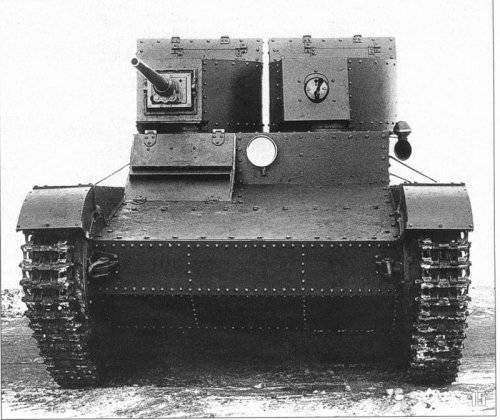
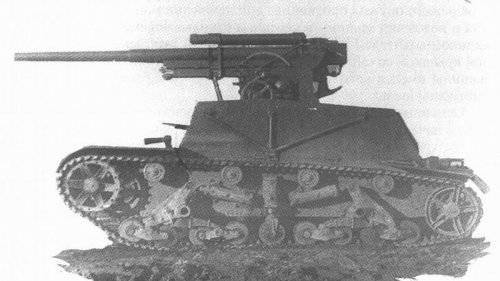
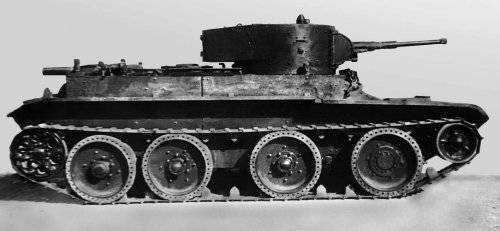
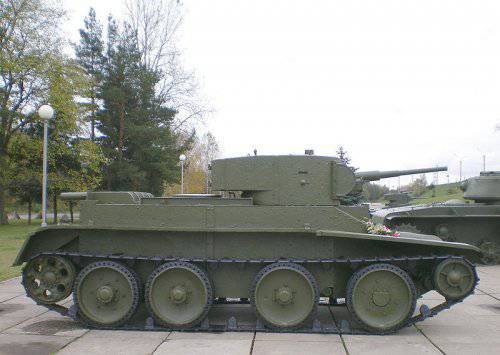
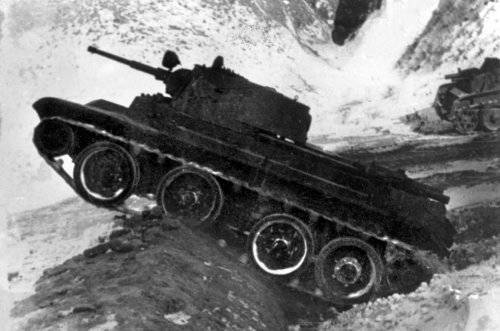
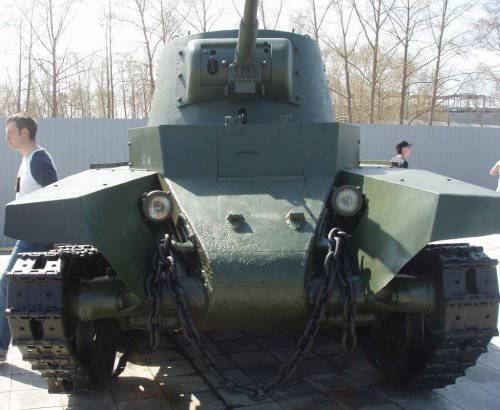
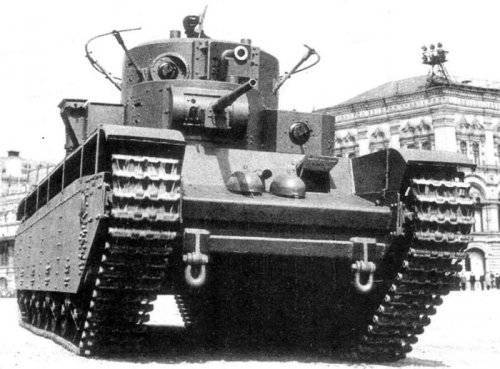
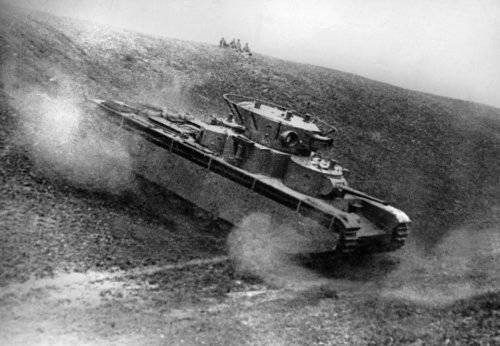
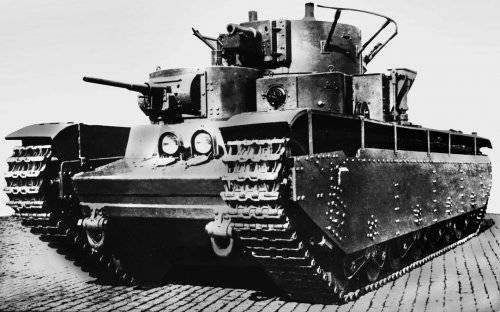
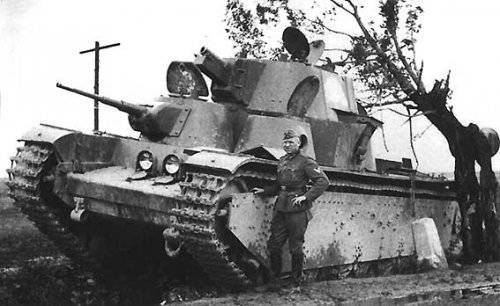
Information